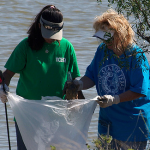What are the Mangrove Trees Telling Us About the Texas Coast?

Dave Fehling?StateImpact
Texas A&M scientist Anna Armitage and mangrove shrub on Pelican Island
The other day, a team of Texas A&M researchers was comparing satellite photos of the Texas coast. As the scientists looked at the images from the past 20 years, they noticed something different: there are now a lot more mangroves.
“Across the whole Texas coast we’ve seen a 70% increase in mangrove area,” said Anna Armitage, a marine biology professor at Texas A&M’s research and teaching campus on Pelican Island. The seaside compound is joined by a bridge to Galveston Island.
“It’s a change and we’re trying to understand what that change means,” Armitage told StateImpact.

Dave Fehling/StateImpact
Coastal grasses along Galveston Bay
What’s a mangrove?
Mangroves are trees and shrubs that grow in the salty sediment along the coast. Armitage talked with StateImpact as she walked through a salt marsh on the island. She pointed out mangroves that had grown to 10 feet tall.
“Even though they’re not huge, they’re much taller than the marsh vegetation. So they out-compete the marsh vegetation,” Armitage said.
Armitage is part of a research team that’s using $400,000 funding from NASA and the U.S. Department of Agriculture to do a three year study on how changes in land development and vegetation are affecting the ability of Texas coast wetlands to absorb carbon dioxide. An increase in mangrove population raises new questions for the team about how climate change is affecting the Texas Coast.
Why are they growing?
One thing they’re looking at is what role hard freezes might play. In the past, freezes that reached the coast are believed to have killed off mangroves.

Researchers (L to R) Patrick Louchouarn, Wesley Highfield, and Samuel Brody
“We don’t know for sure (if it’s related to climate change), because it’s always difficult to pinpoint one particular change,” said Patrick Louchouarn, the principal investigator on the team.
Coastal wetlands are environmentally important for many reasons, but what the A&M researchers are most interested in is what capacity the coast has for absorbing carbon dioxide. Generally, they say coastal wetlands are capable of storing more of the greenhouse gas than inland forests. Therefore, it makes sense to protect or restore wetlands as part of the global effort to reduce greenhouse gases.
A possible benefit as wetlands are lost
The A&M scientists said that mangroves might actually absorb more carbon dioxide than the marsh grasses they’re displacing.
“It could even be a benefit,” said Armitage.
Texas has already lost tens of thousands of acres of wetlands since the 1950’s, mostly due to subsidence, the sinking of land caused when cities pump groundwater. While steps have been taken to reduce subsidence, land development due to the state’s surging population and industrial growth also threatens wetlands.

Dave Fehling/StateImpact Texas
The coastline of Pelican Island, the waters of Galveston Bay, and the refineries in Texas City
Applying the research
“The (Texas) coast is poised for development,”said Samuel Brody, one of the researchers, who besides being a marine scientist, is also a professor of urban planning.
“This is one issue we need to look at. If we’re going to develop the coast and reap the financial benefit, are we sacrificing other, more important benefits,” said Brody.
Wetlands fall under Federal regulation and some states have their own, comprehensive wetlands regulatory programs. Texas incorporates wetlands regulations in several land-use laws and charges several different agencies with enforcement, including the the Texas Commission on Environmental Quality, the Texas Parks and Wildlife Department and the Texas General Land Office.
